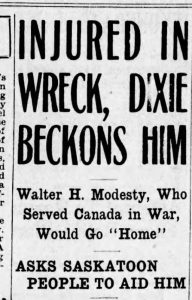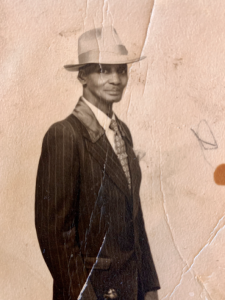Walter’s Life After the Railways
While Walter Modesty may have had pride in belonging to the changing world in his role as a Black porter, there were hardships involved in this work. Porters did not sleep much, were subject to racist abuse, and, despite their hard work, were not eligible for promotions. They were on call all the time – there was no such thing as an eight-hour workday for a porter. Black men were needed, in particular, after the outbreak of the First World War in 1914. When many white men enlisted, this left jobs that needed to be filled. Black men faced many barriers to enlistment until 1916, when the No.2 Construction Battalion was formed. Many men left the railways to enlist, as the pay was better in the military.
You’re Going To Get There (captions available in both French and English). Enjoy this video with an English transcript.
In 1931, Walter was involved in a serious accident while working for the railways. He was working for Canadian National Railways (CN) at the time, and his granddaughter, SC Modiste, believes he was working in the kitchen at the time of the accident. The newspaper articles of the time only mentioned passengers who were injured, not the crew.
This accident was so serious that Walter stayed in the hospital for a long time. In a 1932 article after the accident, Walter mentioned that he wanted to go back to the United States as he has friends and family there. During this time in the 1930s, Walter’s first wife died, making him a single father. He thought that returning to the United States would allow him to receive support from family and friends. CN doctors determined Walter had sustained a spinal injury and would be unable to return to work. He was able to collect wages during his hospital stay, but he would lose them when he left.

This 1932 article from the Star-Phoenix details Walter’s accident and his wish to return to the United States.
The accident occurred during the Great Depression, and finding work was hard. After 1932, Walter left the railways and moved to Toronto. He worked in many different jobs in Toronto including running a successful barber shop. SC Modiste’s mother was born in 1938, when Walter was 68. Walter maintained his connection to the railway, and mentioned visiting the Paramount Hotel. This was a special meeting place for Black porters at a time when many other establishments would not serve them. This landmark hotel was located on Spadina Avenue and has since been demolished.
In the 1940s, Walter and his family, along with other immigrants, were moved to other areas of Toronto as the downtown core was rezoned. They lived for a time at military barracks at General Engineering Company of Ontario Scarborough, Victory Aircraft Malton and finally at the Long Branch Rifle Range. Walter died in 1955, just before his granddaughter, SC Modiste, was born.


